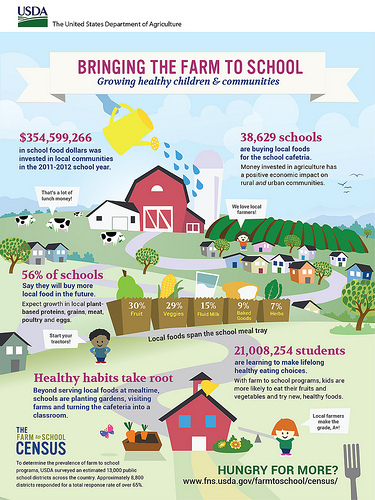USDA Celebrates National Farm to School Month
USDA Office of Communications sent this bulletin at 10/22/2013 09:00 AM EDTHaving trouble viewing this email? View it as a Web page.

You are subscribed to USDA Office of Communications.
| Release No. 0197.13 | |||
| Contact: | |||
| USDA Office of Communications (202) 720-4623 | |||
| USDA Celebrates National Farm to School Month | |||
| Nationwide Census on Farm to School Activities Identifies Over 38,000 Schools with 21 Million Students Serving Over $350 Million in Local Food | |||
|
WASHINGTON, October 22, 2013 — Agriculture Secretary Tom Vilsack today highlighted important strides made in offering healthy, local food to millions of school children through USDA's Farm to School program, and emphasized the program's role in creating economic opportunity for America's farmers and ranchers. According to USDA's first-ever Farm to School Census, in school year 2011-2012, schools participating in farm to school activities purchased and served over $350 million in local food, with more than half of participating schools planning to purchase even more local foods in future school years. "An investment in the health of America's students through farm to school activities is also an investment in the health of local economies," said Vilsack. "We know that when students have experiences such as tending a school garden or visiting a farm they'll be more likely to make healthy choices in the cafeteria. We also know that when schools invest their food dollars in their local communities, all of agriculture benefits, including local farmers, ranchers, fishermen, food processors and manufacturers." Forty-three percent of public school districts across the country reported having an existing farm to school program in place, with another 13 percent of school districts surveyed committed to launching a farm to school program in the near future. Interest in local products spans the school meal tray, with fruits, vegetables, and milk topping the list of local products currently offered in schools across the country, while census respondents indicate an interest in local plant-based proteins, grains and flour, and meat and poultry in the future. Vilsack added that through these efforts, schools continue to enhance the health of the school food environment, meet the new meal standards implemented last school year and demonstrate the role local food can play in school meals. Census results can be accessed online, at www.fns.usda.gov/farmtoschool/census/. School districts that missed the opportunity earlier in the year to respond can submit information regarding farm to school practices through November 30, 2013. USDA's Farm to School Program is part of the Healthy, Hunger-Free Kids Act, which authorized USDA to assist eligible entities, through grants and technical assistance, to improve access to local foods in schools. It is also a core element of the USDA's Know Your Farmer, Know Your Food Initiative, which coordinates the Department's work on local food systems. In mid-November, USDA will announce approximately $5 million in FY2014 Farm to School grants to help school districts across the country further develop their farm to school programming. USDA is focused on improving childhood nutrition and empowering families to make healthier food choices by providing science-based information and advice, while expanding the availability of healthy food.
Collectively these policies and actions will help combat child hunger and obesity and improve the health and nutrition of the nation's children. For more information on the Farm to School program, please visit www.fns.usda.gov/farmtoschool. # USDA is an equal opportunity provider and employer. To file a complaint of discrimination, write: USDA, Office of the Assistant Secretary for Civil Rights, Office of Adjudication, 1400 Independence Ave., SW, Washington, DC 20250-9410 or call (866) 632-9992 (Toll-free Customer Service), (800) 877-8339 (Local or Federal relay), (866) 377-8642 (Relay voice users) |
|||
|
# |


